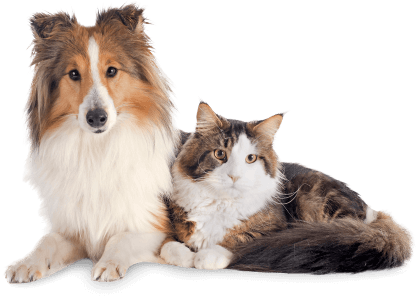Laparoscopic or Endoscopic Gastropexy for the Prevention of GDV
Gastric Dilatation-Volvulous (GDV) is a common occurrence in large and giant breed dogs. GDV occurs when the stomach fills with air and then twists on its own axis. The bloating and twisting cause a cascade of systemic problems that often are fatal if not recognized and treated quickly. Predisposing factors include breed, conformation, temperament, diet, exercise associated with eating and underlying stomach disorders.
Common Recommendations for Prevention Include:
Feeding small meals of large kibble several times a day, avoiding exercise before or after meals and not feeding from an elevated food bowl. The only universally accepted method of prevention of GDV is prophylactic gastropexy.
Indications For Laparoscopic Or Endoscopic Gastropexy
- Previous bloat without twisting/malposition
- Dog who is predisposed to GDV (breed, conformation, temperament) whose owners wish to be proactive in prevention
- Often can be combined with elective anesthetic procedures such as castration or spay
- The procedure recommendation depends upon dog size, anatomy considerations, and your surgeon’s preference and experience. Certain sized dogs, or dogs with extremely deep chests, are better suited for one procedure over anot
Procedure
- An elective procedure performed to permanently fix the stomach to the body wall to prevent twisting of the stomach
- General anesthesia is necessary to perform the gastropexy.
- Use of endoscopy allows gastropexy with 1 small incision:
- The endoscope is introduced through the mouth into the stomach and used to identify the pylorus.
- A large needle is used to hold the stomach to the body wall and visualized to be in the correct place by the endoscope.
- An incision is then made behind the last rib on the right to permanently suture the stomach to the body wall.
- The surgery duration is approximately 35-45 minutes.
- Use of laparoscope allows gastropexy with 2 small incisions:
- The laparoscope is first introduced into the abdomen with a small incision near the umbilicus (belly button).
- The instruments are introduced through a slightly larger incision behind the last rib on the right.
- The scope and the instruments are used to grasp a small portion of the stomach and permanently suture it to the inside of the abdominal wall.
- The instruments and laparoscope are removed and the 2 incisions are sutured.
- The duration of surgery is approximately 35-45 minutes.
Postoperative Care
Incisions take 7-10 days to heal. Sutures should be removed in 7-10 days. The incisions should be inspected daily and excessive redness, swelling or discharge should be reported to your pet’s surgeon. Placing an ice compress over the incision near the ribs will help minimize swelling and discomfort. This cold pack should be applied for 5 minutes 2-3 times per day for the first 3 days. If your pet licks or chews at the incision, you should contact your pet’s surgeon or regular veterinarian for advice. Your pet’s activity level should be restricted during the first 2 postoperative weeks. We recommend continuing to feed your dog several smaller meals per day of large-sized or moistened kibble and avoiding exercise before and after feeding.
Potential Complications
- Postoperative complications are rare and often involve self-trauma to the incisions.
- Any incisional complications should be reported to your pet’s surgeon.
- The gastropexy will not prevent bloating but it should prevent the life-threatening sequel of the stomach twisting.
- If your dog appears bloated, you should contact your primary care veterinarian or the closest emergency hospital as soon as possible.
Prognosis
- The prognosis for dogs who have had a prophylactic gastropexy is excellent.
- To date there has not been a report of GDV in a dog who has received a prophylactic gastropexy.
- The prognosis for dogs who have had a prophylactic gastropexy is excellent.
- To date, there has not been a report of GDV in a dog who has received a prophylactic gastropexy.
The laparoscope and endoscope improve the technique by shortening the time under anesthesia and allowing for a smaller incision, which provides less discomfort than the conventional surgical gastropexy.
Conclusion
It is extremely important that the owners of large and giant breed dogs be aware of gastric dilatation-volvulus and prepare for it. You should educate your family and pet caregivers about the warning signs and preventive measures noted above. You should have the phone numbers for the closest 2 animal emergency clinics to your house so that if a problem arises while your primary care veterinarian is closed, you will have a place to take your pet.
If you are interested in pursuing a laparoscopic or endoscopic gastropexy to prevent GDV, consult with your primary care veterinarian.
